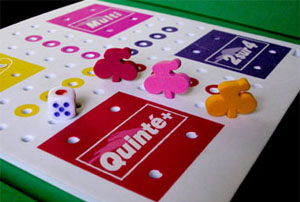
C Y C L I N G B O A R D G A M E S
An
unfinished
text by Anki Toner.
Last updated: may 2005
Preface |
Let's say we made this because we wanted it to be in the net and we couldn't find it (though in the links section you can find some nice sites). The intention was to make a general reference website on cycling board games. Of course, we are far from it.
First of all, we do not know how many cycling board games there are. Second, we do not own or even have seen most of the games we have heard of (not to say the ones we haven't heard of!). Third, making a half-decent website is really a lot of work (making the site we have made is also a fair amount of work). Of course, all additional information, comments, pictures, game session reports, etc... are welcome!
Then, there are other problems, like the internet providers that provide only a limited amount of web space (yes, we were looking for FREE space). Of course we can open multiple accounts, but this makes things more complicated. So we tried to make a site that fitted into 15 or 20 Mb. Which means dropping a lot of the pictures, specially of game parts, that we had taken. (If you are interested in some particular games, contact us, we will send you more pics).
We also wanted to write about these games. About what they are and what they should be. We still want to. This document is all we have been able to do so far. Here again, additions are welcome. Remember that both the website and this document are works in progress, and we do not intend of ever having a final version.
Finally, we wanted all this work to be useful for us. We are game designers, and we thought that writing about other games might be good for our designing process. For the record, we have designed, so far, three unpublished cycling board games (well, we only have finished two of them: the third is going to be the good one, it will be the best game ever, blah, blah, blah...
I. What is (and what isn't) a cycling board game?
Among the many categories in which board games can be classified (1), there are two into which cycling board games fall naturally. These are "racing games" and "sports replay games".
Sports replay games are those which replay a sporting event and, of course, cycling games are those who replay a cycling race, be it a track race or the Tour de France.
H.J.R. Murray, in his classical book A History Of Board-Games Other Than Chess defines race games as "games in which teams of equal size race one another, along a given track, and the first player to complete the course with his team wins. The moves are controlled by the throws of dice or other implements of chance [..] The typical English games of this class are backgammon, ludo, and the game of goose." (2)
Although this definition suits most cycling board games, it is too restrictive for some of them.
First and most important, not all cycling games are games of chance. Although none of them is a fully tactical complete-information game (like chess), some of the most interesting cycling games try to avoid these "implements of chance", and many more try to limit the chance factor in some way or another (for instance, using card draws instead of dice throws, which allows for keeping a hand and thus having a choice of possibilities to play).
On the other hand, although real-life cycling competitions usually have "teams of equal size", they never have teams of equal strength, not even of equal objectives. This is a concept one would rather associate with a game like RISK: teams (or armies) of unequal strenght trying to achieve different goals, but which is also introduced in a few complex cycling games, in which players manage teams and may take some strategical decisions (for instance, buying a sprinter instead of a climber).
These are an exception, though. In most games players run either a single cyclist or a small team af cyclists (smaller than a real-life team, at least).
Of course, games in which players have a single cyclist and which control the moves by the throws of dice, are not that far from the game of goose. As well, games in which players have a small team of cyclists of equal strenght can be likened to parcheesi (a game you surely know, though maybe you call it "ludo" or "the game of india" or "pachisi" or "le jeu des petits chevaux"). An important difference though is that in a cycling game all riders are (generally) moved every turn, while in parcheesi (or backgammon) you can leave some men behind for a while. Another difference is that the winner in parcheesi (or, again, backgammon) is the player to enter his last man, a feature not very realistic in a cycling game.
Personally, I expect a cycling game to be more than a game of goose with cyclists instead of gooses, the Tourmalet instead of the well, and a puncture instead of the prison. Also, if I want to play parcheesi (by the way, a personal favourite), I don't need to play it with cyclists.
A cycling Parcheesi

I don't expect, however, a board game to reproduce every aspect of real-life cycling. Generally the number of teams will be much smaller (more than twenty teams take part in the real Tour de France), the number of riders per team most probably too (a real team has 9 riders in most races), the diffences between the riders will be oversimplified (some games have specialist "riders": -climbers, sprinters-, some games don't even have this distinction) and the total lenghth of the game will never be close to real time (one can make a near-real-time football board game, but it takes over 90 hours to win a Tour de France!).
Of course not every cycling race is the Tour de France. There are also much shorter races, one-day races, there is track cycling, there are even mountain bike and cyclo-cross races. Most of these have their games too, and hopefully they will be distinct games. In fact, there is a vast array of possible cycling games, which we will try to examine. The first thing we have found is that there are many more cycling games that we thought (there are hundreds!) and that classifying them is harder than we could imagine.
II. What should a cycling game have.
Being a particular subclass of the sports-replay-racing-games category, one expects cycling games to have some kind of distictive features that makes them different from, say, horse race or motorbike race games. R.C.Bell describes a horse racing game of mid-XIXth century, "The Game Of The Race", thus: "It sported an oval track. The riders progress was controlled by the throw of a six-sided die. Along the course were hazards."(3) Of course, some early cycling games were not more specific than this (except, of course, the counters were NOT in the form of horses). Other early games were literal adaptations of "The Game Of Goose" superimposed on a map. At least these were good for learning geography. But times have changed, and what made a nice, much sought-after, pre-WW1 game, is probably unacceptable eighty years later.
Jeu de l'Huile de Table des Chartreux,
Criterium Degli Assi: cycling games of goose


Some of the distinctive features that make a game worth calling "a cycling game" may vary depending on the type of race represented by that game, but others should be built-in in the mechanics of the game. The two crucial issues of cycling are recovery from effort and protection from the wind. Any cycling game that does not consider these runs the risk of being simply a race game with bicycles. Nevertheless, these are two difficult features to implement.
By "recovery from effort" I mean the fact that a cyclist cannot simply ride as fast as he can all the time. He has a limited amount of energy which he has to save during the race to be able to use it at important moments (trying to break away, climbing, during the final sprint...). A sports replay race game that does not takes this into consideration could be a motorbike race game as well.
By "protection from the wind" (which I could also have labeled "aspiration") I mean the fact that a cyclist riding behind another or inside a peloton saves energy because he is protected from the wind. Of course, this energy can be used to increase speed when a number of cyclists relay one another. The result is that a peloton usually runs faster (and with less effort) than a single rider. If a game fails to include this, it may be closer to an athletics race game, or a snail race game for that matter.
Of course, there are many other important features in a cycling game. The most obvious is the "Touch & Feel" factor: the name of the game will probably bear some relation to a cycling race, the board will represent a road or a velodrome, the counters are expected to be cyclist-shaped (unfortunately, too many games do not fulfill this expectation).
Except when the game represents a velodrome race, it is very possible that some parts of the course will be marked as "ascent", "descent", or even "pavés", and that some special rules apply to these sections. We may also find special "sprint" rules for the end of the race, or even for intermediate sprints.
Another relevant feature is that when teams are composed of more than one cyclist, some (or all) of them may have special functions (leader, sprinter, climber, rouleur...). This is quite uncommon in race games other than cycling games.
The order in which players move, typically, is determined by the position of the cyclists in the game. The riders ahead move first. This is a common feature not only of cycling games but of almost all sports replay race games.
The winner of the race can be either the first to cross the line or the one that goes furthest past the line in the same turn. Most games prefer the latter. Since the riders ahead move first in the majority of the games, the former option is quite equivalent. (The winner, most of the times, will be the rider who moved further in the turn before the last).
All the games that represent a stage race need some kind of rule for recording race times. This implies that each rider in the team has its own identification number. Some games simply give points to each team according to the position his riders were placed in the stage. This reminds me more of a Formula 1 grand prix than of a cycling race. But some track races are won by points, and the Tour de France used to be a point race, circa 1910. It still has a points classification, awarded with the green jersey.
When a game represents a stage race, it is advisable that the stages are quite short to play (some game designers forget that, though) so one can play several stages in a reasonable time. Generally these will make the stages simpler, since much of the interest lies in the fight for the general classification. A game that represents a single race can have more complex mechanics. Some games offer different levels of play for the players to choose. The most ambitious games even have a team-management level.
By the way, a stage race should include a time-trial stage. This is a difficult point, since the mechanics of the games do not always translate well into time-trial racing.
Speaking of games' mechanics, a very important point is whether there is much luck involved. Needless to say, the possibility of making some kind of decision is what (generally) makes a game worth playing, but a certain amount of randomness is what makes it worth playing twice (well, a lot can be said about that). When we think of the influence of chance and/or strategical thinking in cycling games, we must compare them with real cycling. No doubt, there is a fair amount of chance in the cycling sport. Not only as avoiding of bad luck (like not having punctures or falling), but in also in a more subtle level. As Mike Clifford put it, "the random nature of a split from the peloton is surely the reason why people watch the sport." In cycling games, however, there is A LOT of chance involved. The simpler games are basically games of chance. Most games try to balance the chance and skill elements. Some rare games don't have dice throwing or card drawing, minimizing thus the effect of chance.
I haven't seen, however, any cycling game in which no luck is involved. This would make it a complete-information game, and there are no complete-information games for more than two players. Simply being more than two players implies some degree of chance (or of chaos).
And of course most cycling games are meant to be played by a certain number of players, and work better with more than two. Although there are a few games designed for just two players ("Giro Binaca") and even some replay games designed for just one player, most cycling games are multiplayer, and their mechanics are open enough to admit different numbers of players. Most games mechanics would only need minor changes to admit, say, a dozen players. Of course, to be realistic, a cycling game should have many more players than it generally does.
Finally, there is one feature that I personally hate in cycling games. As has been said before, some cycling games are educational: children can learn geography with them. Some games carry this even further and include some Trivial Pursuit-like question/answer cards. (The Official Tour de France 2003 game is the most recent example). I find this absolutely non-cycling. Moreover, it makes absolutely inmpossible to make a quick translation of the rules (you would have to translate all the questions). If the game is interesting enough (I am thinking of "Kelme" or "La gran Vuelta Ciclista en casa") you can always use your own alternative rule instead.
III. Classification of cycling board games
There are many different possible classifications of cycling board games. The first thing that comes to mind is to classify the games according to their antiquity and/or country of origin. This may be a good approach from a librarian point of view, but sometimes is is not so easy.
It is generally difficult to date the games with an accuracy better than a decade. The country of origin is also unclear for certain games, as some games have been released and/or reissued in different countries (Homas Tour, Um Reifenbreite, Demarrage...)
On the other hand, we are more interested in a classification of board games according to their rules. We will study five major features of the rules, which will help us to classify the games.
1 - Type of race:
A) Track Cycling (velodrome). These games are played on an oval track and provide no rules for such things as climbing, descent, pavés, climatic conditions... They neither have time-keeping rules, since the track races are not supposed to be stage races (although there might be a points classification).
B) 1 Day Road Race: These may include rules for such things as climbing, descents, paves, climatic conditions... but still no time-keeping rules. Of course, on most stage race games you can play a single stage without the game losing much interest, and, on the other hand, most 1-day-race games can be played by stages if you make your own classification rule.
C) Stage Race: These need some kind of classification-keeping table, and a rule to convert the results of one stage into time or points. Another very important and often forgotten difference is that the playing time of one stage can (and probably should) be shorter than in 1-day-race games. Most stage race games limit themselves to 5-6 stages, though generally nothing in the mechanics of the games imposes this limit. There might be different type of stages: flat stages, mountain stages, and even time trial stages.D) Other cycling races: BMX and mountain bike games should be included in this category -and I am still waiting for a cyclocross race game!.
E) "Cyclotourism": This category includes all games that do not do not fully grasp the spirit of a cyling race, but are nevertheless cycling games. Games in the Cylotourism category range from an early classic as "Messenger Boy" to childish games like "Cabbage Kids Bicycle Race".
A few games may enter into more of one of this categories. "Criterium", for
instance, offers a two sided board, with road cycling on one side and a track on
the other.
2 - Team composition
A) Mono: Each player controls a single rider.
B) Equal Team: Each player controls a team of equal cyclists (no specialists)
C) Non-equal Team: Each player controls a team of different cyclists. These are generally specialists (a leader, a climber, a sprinter, sometimes a rouleur, one or more domestiques...), though in games like "Le Jeu Officiel du Tour de France 1988/89" or "Attaque" we find many different parameters for each individual cyclist.
D) Manager: The players have decision power over the composition of the team. Sometimes by buying the riders ("Kelme"), sometimes by distributing points (energy) or other parameters among the riders. ("Classiques du Cyclisme", "Breaking Away", "El Juego de la Vuelta Ciclista")
This issue will be further discussed in chapter IV.
3 - Commercial distribution
A) Commercially distributed boxed games. Most known games (and the best known among them) fall into this category. A commercial game can be quite complex and/or good looking, since they don't need to be specially cheap. It is a business decision: what will sell more, a beautiful looking expensive game or a cheap lousy one?
B) Promotional games. Generally these will be cheaply produced games, and quite simple too, although there are exceptions like "Cyclo". These games might be quite hard to find, if you are not at the right place at the right time.
C) Games included in games' compilations. These tend to be simpler too. At least in one case the game has been published both as a game in a compilation and a stand.-alone game ("Radfahren", but I don't think it really deserved a stand-alone edition).
D) Games included in magazines. I don't know many of them and they are all quite special, so in the end it is one of my favourite categories. There are games published in children's magazines (al the "corriere dei Piccoli" saga), in cycling magazines (Pello's "Le Petit Tour de France Miroir-Sprint") and even in art magazines ("La Serpiente Multicolor")!
E) Self-made self-distributed (or even unpublished) games. There must be hundreds of unpublished cycling games around. I have three or four myself (counting the unfished ones, but that is yet another category). Some people send me their rules to see what I think, some people put them for free on the net (like Claudio Vianini), some people sell the game on-line ("Attaque") or make small pseudo-commercial runs ("Le Tour Cycliste"). The first problem with these games is to discover them. (The second problem, of course, is that they tend to be under-tested vanity games. Though not all of them are).
4 - Strategical possibilities
A) Zero-strategy games. Simpler games have a zero strategical level.You throw a die (or even two), you advance your rider(s), you might even take a chance card if you land on some squares. There's nothing you can do to improve your performance (except maybe cheating). Of course, these games can have a certain charm, specially if they are old enough and/or the graphics have some value in theirselves. But not even being a free promotional game is an excuse for "Sur La Route du Tour"!
B) Poor. The players can take some simple strategical decisions, like moving fewer spaces than rolled (to take advantage of special squares or of simple aspiration rules), changing lanes, keeping a chance card for a later turn...
C) Average. The player can take different decisions for different riders according to the situation of the race. Maybe different riders in the team have different goals or different capabilities.
D) Fair. Allows planning future moves (for instance, if riders advance by drawing cards). As a result, some kind of energy management is involved, either explicitely or implicitely.
E) Strategy oriented games. The chance factor is minimized. Riders' advance is not based on dice throwing or card drawing.
Strategy is a parameter that might appear to be
related to factors like number of riders in a team, or realism (the more
features the game has, the easier it is that these involve some kind of
decision-taking), but it is not exactly so. Two of the most strategical
cycling board games I know are "Breaking Away" and Holtmann's "6-Tage Rennen".
And the one thing these games have in common is their bareness of
non-essential elements. Of course, one can think of taking the basic mechanics
of these games and try to add, say, a mountain section. It would make a more
complex game, though it is not probable it would be a better game. It probably
would look like Templum's "Peloton" (which has a fair amount of strategy
involved too). 5 - But is it a good game?
A) Forget it! In the end, of
course, this is the only parameter that matters, although it is a quite
subjective one.
There is no such thing as a perfect game. A good game, either simple
or complicated, should have a balance between its intentions and its rules.
Many cycling games, unfortunately, are either too simple or too complicated,
either uninteresting or unplayable.
This is a design decision, nevertheless, and one to be
respected. If someone wants to make a cycling game for 5-year olds, I will not
object, as long as it is clear from the beginning and the game is coherent all
the way. (But I hate adult-oriented games with childish sets of rules). On the other
hand, if you want to make an overcomplicated, hiperrealistic cycling
game, one that takes weeks to play, it's fine. But admit it is aimed at a few
hardcore gamers. Don't expect to please a casual player.
IV. Elements
of a cycling game. Different solutions for common problems.
As I said,
this is an unfinished text. This section will probably remain unfinished
forever...
but it has grown! I have so far centered on the rules of the some of the most
interesting games in my collection:
Um Reifenbreite (aka Homas Tour, Demarrage), Sechs-Tage Rennen (Holtmann's), Der Ausreisser
(aka L'Échappée, Der Favorit), Milk Race Game, Die Tour, El Juego de la Vuelta
Ciclista, Vuelta Ciclista Kelme, Cyclo, Maillot Jaune (aka Le Jeu de Bernard
Hinault, Les
Géants Du Tour, Winning), Classiques Du Cyclisme, Table Tour, La gran Vuelta
Ciclista en casa, La Serpiente Multicolor, Eddy Merckx, El Juego de los
Ciclistas...
Nevertheless, I mention rules of many other games, even if it only is for
comparison purposes. In this section we
will have a closer look at the elements introduced in chapter II. (Type of
race and team composition have been introduced in chapter III).
1 - Team composition and goals A relevant feature of
cycling games is that when teams are made of more than one cyclist, some (or
all) of them may have special functions (leader, sprinter, climber, rouleur...).
On the other hand, although real-life cycling competitions usually have "teams
of equal size", they never have teams of equal strength, not even of equal
objectives (some teams go for the general classification, others would be happy
to win a couple of stages). We will examine team composition of the games that
have riders with different abilities. In a few complex games, players manage teams and
may take some strategical decisions about team composition. In Kleo's "Official Tour
de France Game" we find teams of up to 9 riders which are chosen from real
1988 season cyclists, each of them having their own parameters for three
categories: flat road, ascent and descent. It is recommended to play races with
teams of three or four riders (unless you are really serious about spending a
lot of hours for each stage). In "Classiques du Cyclisme" we find a team of 6 men, one of them being the
"leader", and the rest "domestiques", though one of them can double as
"sprinter". Each rider has his own parameters (which are "Profile1-Flat",
"Profile2-Pavé", "Endurance", "Demarrage", "Work" and "Power"). Of course, since
the game is supposed to replay the "Paris-Roubaix" race, there's no need for
climbers, but if they ever release another board (as they say they will), there
could be a "Profile3-Uphill" parameter. The team director (the player) decides
the magnitude of these parameters for each rider (within the limits of 110
points for the whole team). "Attaque" only has 3 riders per
team, but they also have a lot of individual parameters: Each player choses for
each cyclist his strength as Sprinter/Climber/Rouleur (the more of one, the less
of the others), but also such things as "experience", "mental strength",
"balance", "Resistance" (again, the higher one parameter, the lower the others),
and even "resistance to cold weather", "resistance to hot weather".
In "Kelme", each team consists of 3 riders, a "leader", a "climber" and a
"rouleur", which you have to pourchase with a limited budget. The more you spend
on one rider, the less is left for the others. (In this game, a more expensive
rider will have more free turns). Moreover, the "leaders" advance one square per
die point, all trough the race, while both "climbers" and "rouleurs" have zones
in which they just advance half a square per die point.
Some other games feature riders with differen abilities, but players can't
decide about the team composition.
In "Cyclo" we have teams of 5 riders: a "leader",
a "climber", a "sprinter" and two "domestiques". "Leaders" advance an extra
square all through the race. "Climbers" advance two extra squares in mountain
sections (both uphill and downhill!) "Sprinters" may use a third die in the last
section of the race. "Domestiques", naturally, don't have any of these
advantages.
In "El Juego de la Vuelta Ciclista", each team has 4 riders: a
"rouleur", a "climber", a "sprinter" and a "domestique". According to the type
of road (ascending, flat, descending or sprint), they will have a different
degree of energy spending for certain actions. (The "domestiques" will pay extra
energy points if they try to break away, whatever the type of road -they are not
supposed to!-, but less for other actions, whatever the kind of road they are in
- they are supposed to do the dirty work). In "La Serpiente Multicolor" we have team of 4 riders:
leader, climber, rouleur and sprinter. Each is specialist in one kind of road,
except the leader who is specialist in all.
It is interesting to note that while in most games the riders have numbers to
distinguish them, a few games have a different figure for each kind of rider.
"La Serpiente Multicolor" uses a color code, each rider wearing a
different cap. If the color of the cap matches the color of the road, then the
cyclist may advance some extra squares. In this game, there are some cards dealt at the
beginning of the race and which are placed face-up on the table for all players
to see, that give different extra abilities to each team. The race, thus, is not
exactly balanced but all players know which team is better in what. These cards
may be extra advances in some section of the road, extra advances depending on
the position of the rider in the race (like "the second catches the first"), or
extra energy ("energy drinks"). "La Etapo" also deals
different "tactic cards" to each player at the
beginning of the game (although after reading the rules I am not sure whether
they must be shown to the other players or not. In any case, these cards have
text on both sides -French on one side, Esperanto on the other. The rules,
nevertheless, mention the "blank side" of the cards). In "54x12" these "strategy" cards are hidden from the view of other players.
They are dealt once at the beginning of the first stage.
In "Die Tour" we have teams of
four riders, one of them marked as "team leader". The other three are
"domestiques". Of course, some of the cards
offer a better performance for the leader. In "Table
Tour", with teams of 3 riders, we also have a leader and two domestiques.
Solo replay
games (like Mike Cliffords's "The Tour") though not properly board
games, also present riders of unequal strenght. In the US we can find a lot of
(non-cycling) sport replay games featuring teams of non-equal strenght. But
then americans love statistics.
2 - Type of road
B) Poor. What's on TV?
C) Average. Maybe we'll play it again some day.
D) Good. When are we playing it again?
E) Addictive. Let's play again right now!
There are two common approaches.
The first one (and my favorite) is the wide field road, in which there are no
lanes (although there might be a limit on the width of the road, of the number
of cyclists that can share a field). In this one the riders just have to
advance (as opposed to zig-zag). I think this is more the feel of a cycling
race.
Wide Field: A Qui Le Tour, Die Tour
The second widely used road design is the road with lanes (which we can call
"checkered road"). In this one riders not only advance but can move laterally
(or at least diagonally) in order to block other cyclists or avoid to be
blocked by them. To me, this sounds more like a motorbike race or formula one
game. I mean, "Speed Circuit" is a great game, but it is not a cycling game!
Checkered: Homas Tour, La Serpiente Multicolor
As an exception, a couple of games ("Criterium", Templum's "Peloton") feature
hexed roads.
Hexed: Criterium, Peloton
It should be mentioned that "L'Echappée" (aka "Der Ausreisser") does not even
have a board (though in purity we could say it has an implicit wide-field
road).It is a rare exception that probably does not even fit in the
"race game" category (though it is a cycling game).
3 - Winning, classification
Even in simpler games, where the player controls a
single rider, and where only one single race is played, the are a couple of
options for deciding the winner. It can be the first to cross the line or it can
be the one who goes further past the post on the same turn. Most games take this
second option (and break the ties with an adaptation of the first option: the
first rider to have reached the field goes first. This is related to the order
of play, of course).
In single-race multiple-cyclists-per team games, one
has to decide whether the winner of the game is the team with the individual winning
rider, or the team with a better global result. (What I haven't seen is the
classical racing game approach of backgammon or parcheesi, where the winner is
the player who enters first his last man: definitely a non-cycling approach!)
Back to the global result, the problem is to define it. Many games ("Um Reifenbreite" among them) use a Formula 1 approach
(again): 10 points
for the winner, 9 points (or 6 points, for that matter) for the second, etc.
Some points can be also awarded at intermediate sprints, mountains... The
distribution of the points is quite unrelated to real cycling races. A good
approach would be to take the prices (in euros) of a real cycling race and use
them as a guidance. (One has to remember, though, that a real cycling race
prices are shared between more than one hundred riders, and this is hardly the
case in a game).
Some games ("Eddy Merckx") do use money instead of points. The first riders or
every lap are rewarded with money. The team with more money in the end is the
winner of the game (though perhaps not of the race!).
In multiple-stage games, though sometimes we find
points classifications, there is a tendency to measure something similar to
minutes and seconds, for the sake of realism. The problem, of course, is
translating turns and dice throws into minutes and seconds. In games with a big number of riders, keeping track of these
classifications can be quite time-consuming! My friend Yann Moreau runs a PBEM (Play By E-Mail) cycling game (http://fr.groups.yahoo.com/group/jeutdf/)
which is almost a board game (by the way, it will one of the good ones if
it ever turns into a real board game). Nevertheless, he has had to make a
program to keep the classifications. Presently, his calculations are too complex
for a board game. The simplest approach is to convert any extra
turn needed to cross the finishing line into a time unit (tipically, one minute,
though "L'Echappée Infernale" counts only 30 seconds). This rule alone causes a
lot of ties in the classification if there are enough riders on the race.
A finer approach is to count also the number of squares passed after the
finishing line ("Die Tour", "Peloton", "Cyclo") or before it ("Milk Race Game")
"Cyclo" adds 10 seconds for each extra move and then substracts 1 second for
each square behind the finishing line. Although the game is played with two dice
(and sprinters may use three dice) there are only nine squares past the
finishing line. All the riders in the same group (no free squares between them)
get the same time that the first of the group.
"Peloton" adds 1 minute for each extra move and then substracts 10 seconds for
each hexagon behind the line (5 seconds for half-hexagons). The trouble with
this is that there are very few riders with the same time. It looks more like
a mountain stage than a flat stage.
In "Milk Race Game", the stage time for each player is 4 hours. Every player
accross the line in the winner's turn, irrespective of position, takes 4 hours.
The winner gets a 15 minute (!) bonus. All other players take 4 hours plus 2
minutes for every mile they are behind the line (a square is 2 miles, so it's 4
minutes per square). There are also bonuses for intermediate sprints and
mountain sections.
In "Die Tour", when the first rider reaches the
finishing line, all the riders in his group get a time of 0 minutes and so many
seconds as are written on the field this rider was on before he moved. From this
moment, each turn counts as one minute, and a similar rule applies to the other
groups.
"Die Tour". Notice the seconds written on the board, before the finishing
line ("Ziel").
Strangely, Kleo's
"Official Tour de France Game 1988/89" counts dice throws but does not convert
them into minutes or seconds. I would have bet it would offer a more complicated
system!
Of course, there is no reason why you shouldn't
implement a points classification instead of a time classification. "A qui le
Tour?" offers both (and a mountain classification and a sprint classificxation
too!). For the time classification, riders who cross the finish line on the same
turn (or draw) are classed with the same time. On the flat stages (i.e. not the
Alpes or the Pyrenees), riders who arrive on the following turn are classed
equally with the same time. On the other hand if they arrive two or more turns
after the leading rider then they are considered to have lost 40 seconds on the
leader for every second turn. The same principle applies to the mountain stages
but riders arriving an odd number of turns after the leader draw a supplementary
movement card from which they read the number of seconds that they lose
respect to the riders from the previous turn.
"La Gran Vuelta Ciclista en casa" offers a lot of
classification systems, including money, points and/or time. Its time calculation method is quite complex.
The game uses a chase car as a chronometer. This car advances two fields each
turn, so you can easily know the number of turns spent by checking which field
it is on. Then we have a different system for each time of stage (short, long,
mountain...). This counts the hours and minutes. The seconds are "equal to the
last die throw multiplied by ten minus the number of squares between the rider
and the one inmediately following him. The last rider will count the number of
squares between him and the chase car". Of course, the time-trial stages
are counted differently.
"Attaque" also has a different count depending on
the stage. For flat stages it is as low as one second per turn. In high mountain
stages, you have to throw two dice for each turn to determine the seconds. So
each turn can be anywhere between 2 and 12 seconds. Time trials and medium
mountain stages use only one die.
Track racing, however, has different classification systems, both in real
cycling and in games: In Holtmann's "6-Tage Rennen" you play as many races as
you choose (6 races is recommended), and there is a points system: Points are
scored at three different times during each race. The first rider to cross each
of the sprint lines scores 5 points, the second rider scores 3 points, and ther
third rider scores 2 points and the fourth 1 point. The last sprint of the lap
counts double. But, at the end of the race, a player loses a lap for every four
spaces between her rider and the Start/Finish line, up to a maximum of 5 laps.
When a game consists of only one race, the number of laps lost is irrelevant.
But when a game consists of more than one race, laps down become even more
important than points. At the end of the last race, the player who has lost the
least amount of laps will be the overall winner. If two or more players are tied
for the least amount of laps, the player among them with the most points wins.
Finally, it should be noted that some games ("54x12", "La Etapo"), in their search for realism, go as far as offering a different
cycling figure with the yellow jersei. The leader of the race will replace
one of his riders with this figure. "Richard Virenque" features a nice Virenque
figure, supposed to replace the leader's rider. The objective of the
game is not exactly to win the race but to be Richard Virenque (although, of
course, you have to win the race to be him).
4 - Turn, order of play
Most games follow the natural order of the race. The
rider in front moves first. When there is a tie, the rider who first arrived to
the field will move first. There are not many exceptions, but in a few games
("Jeu du Veldiv",
Holtmann's "6-Tage Rennen", "Classiques du Cyclisme", "L'Echappée
Infernale", Kleo's "Official Tour de France Game", "Winning", the "Cycling" game
in the "Superstars" compilation) the order of play is the order in which the
players are sitting round the table (the order in which players started the
game).
"La gran Vuelta Ciclista en casa" recommends to move first the rider 1 of each
team, the rider 2... but admits the "round the table" order of play to speed the
game.
As an exception from the exception, "Der Ausreisser" uses a mixed strategy (the
leader of the race moves first, the players in the peloton move according to
their place on the table).
"El Juego de la Vuelta Ciclista" has an unusual division of the
game turn. Called "game cycle", it is performed each time by a diffferent player
(his role at this moment being just to control that the movement of the riders
is right). The "game cycle" is divided into "plays" (one for each peloton in the
race) during which players perform "actions". It looks quite complicated the
first time you see it, but it is not so. Basically, it means that the actions
("acceleration", "acceleration cancellation", "breakaway", "breakaway
cancellation") do not affect so much individual riders but the whole peloton in
which that rider is (quite an interesting unusual concept. Of course the
breakaway action affects the individual rider, but in the end it just creates
another peloton, of one rider if the breakaway has been fully successful, or of
more than one if other riders have joined the breakaway). The order of play starts
with the first peloton and follows the order of the race. 5 - Cyclists' advance
Once we have agreed the order of play, the next important thing is how we
advance the riders. The vast majority of games use dice, generally one or two D6 (by D6 I mean a normal six-sided die, with
sides numbered 1 to 6, in case you are not familiar with the terminology).
The first problem with dice is the big difference between throwing a 1 and a 6
(not to say a double one and a double six if you play with 2 D6). Then there
is the problem of the uniform distribution of the throws which is not
realistic in a cycling race. The distribution is somewhat better with 2 dice,
closer to a normal distribution, which is what real-life distributions
generally are (enough of that, I am not going to give a course on statistics
here). Some games try alternatives like a spinner ("Milk
Race Game", VDO's "6-Tage Rennen", the "Bicycle Race" game
included in 1905's Milton Bradley's "Junior Combination Games"), which in purity is another form of a
die (though not a D6), or special dice ("La
Etapo", some Corriere dei Piccoli games). I would expect to find a game using
a set of role-playing dice (D4, D6, D8, D10, D12 & D20). I was thinking of
doing it myself, but I ended up with a game using four special dice (223334,
23344X, 3445XX, and 001122, where the X marks the loss of that die). I am
going to publish the rules of this game one of these days.
"Milk Race Game" spinner. The dice
are only used for the time trial stage and the "sprint shake-up"
VDO's "6-Tage Rennen" has a strange
"speedometer" spinner. Not exactly what I would call cycling...
"La Etapo" uses a die with 3 values
on each face (flat, ascent, descent). Notice the (unused) weather
condition signs.
The Corriere Dei Piccoli games, even if they were quite
simple (it is a children's magazine), featured non-standard D6s. These are from 1964's "El Gioco Del Giro"
Another approach with dice is to throw as many dice as riders in your team, and
assign each die to the rider that needs it most in that particular moment of the
race. "L'Echappée Infernale" or "Milk Race Game"'s time trial stage
use this one (by the way, it is a quite a good approach to a team time trial, in
my opinion). My friend Yann Moreau has
tried it with good results on one of his unpublished games,
and I am thinking
of designing a game using this approach too. The rest of the rules in the game
(including the winning rule) should avoid that the optimal strategy is to
always assign the highest die to the leading rider (if it's just that, it
wouldn't be very interesting).
Kleo's "Official Tour de France 1988/89" uses dice
in a different way. In Kleo's game, the number on the die is not the advance
of the player, nor something to be added to the avance of the player, but an
indirection to a table where the advance is written. Each type of road and
each rider have their own table.
A very different approach, and a more realistic one as I see
it, is using cards to move the riders. The idea is that the players are dealt
some cards and the remainder are laid face down on the table. As cards are
played they are replenished from the face down pack. If you spend high cards,
you can expect to be replenished with lower cards, and if you play low cards for
a while, you see your hand value slowly increasing. This is very realistic. You
may be have a good moment (every cyclist knows this sensation) and get some
consecutive good cards, or you feel increasingly "tired" as you draw one bad
card after another. As I say, quite realistic. Games using cards include "Table
Tour", "Der Ausreisser", "Devil Takes The Hindmost", Holtmann's "6-Tage Rennen",
"Die Tour", "Criterium" and "L'Echappée du Tour".
Another interesting point with cards, although not many games
use it, is that a hand with fewer cards offers fewer choices (and probably fewer
good cards). In "Table Tour", the team with the last rider in each stage loses a
card for the following stages. A problem with cards is that in
most of these games you have the same hand for all your team. I label this
"collective energy, and it is quite unrealistic. "L'Echappée du Tour" deals a
different hand for each rider (a nice try, altough you finally get quite
confused with so many cards on the table, specially when the cards in this game
are poorly designed). "Der Ausreisser" and "6-Tage Rennen" are games with only
one rider per team, so they can't have a "collective energy" problem.
In some of these games the players draw a card to replace the one played, always
having a hand with the same number of cards ("Der Ausreisser", "Devil takes The
Hindmost", while in other games the players have to play only whith the cards
received at the beginning. In "Die Tour", players receive 15 cards, and three
more in the final part of the stage (a surprise for the sprint?).
"Die Tour", by the way, has custom-made cards with strange signs. All the team
is moved with one card.
"Um Reifenbreite" uses a somewhat mixed approach.
Though it basically is a 2xD6 game, the players have some energy cards (with
face value of 5 or 6) that can substitute the throw of one or both dice.
Another possibility with cards is the one used by the worldwide famous game
"Mille Bornes", which is copied shamelessly by "Les Cracks". "Itzuli Mitzuli" uses
a similar scheme. Even "Laurent Fignon", a dice game, uses some of "Mille
Bornes" mechanics (the attack and defence cards). I particularly hate this.
A few games use mechanics in which no (or not much) luck is involved ("Breaking
Away", Templum's "Peloton", "Maillot Jaune",
"La Serpiente Multicolor", "Classiques du Cyclisme").
In Templum's "Peloton", the cyclist's speed is determied by three factors. The
basic speed is given by the type of land (flat, uphill, downhill; 3,2,4 hexagons
respectively). Then one may add an aspiration factor (one extra hexagon) under
certain circumstances. In addition, a cyclist can gain another acceleration of 1
or 2 hexes by marking it on his card (see picture) and substracting that amount
of energy. In "Maillot Jaune" the die is not
used to advance the riders: they move 2 or 3 squares depending wheter they are on
favoured section (flat, uphill, downhill) or not. However, they can move further
if they try a "breakaway", which can involve "risk" or not. The energy wearing depends on the "risk" factor, and
the "risk" factor is determined by the throw of a die. Theoretically you could run the whole race without throwing the die. The
problem is that you would never win the race with such a tactic. According to the
makers of this game, no luck is involved, being thus a purely strategical game.
This is absolutely false, since all riders will finally take the risky option
and the winner will be the luckier with the dice.
In "La Serpiente Multicolor" riders advance up to a given number of squares
depending of the road section they are on and the rider's speciality. There is
no dice throwing or card drawing. Like in "Maillot Jaune", a rider may
try an "extra advance" with some risk. This involves throwing a die and reading
the results on a chart. The most probable thing is that the rider has to pay an
energy point but isn't able to move! Nevertheless, he may be able to advance up
to two extra fields, and might not have to spend energy. In
"Classiques du Cyclisme", the riders add
certain parameters depending on the type of road they are in and the card that has been played (or whether a card
has been played). Some of these parameters do not move only a cyclist but
the group in which he is in. In "Breaking Away" the riders advance with a value called
"replacement factor", the initial value of which is decided by the player at the
beginning of the game, and then is decided by the position of the rider in the
race. The mechanics of this game are absolutely poriginal, and one of the best
you can find. They will be examined more closely in the section "Aspiration"
(see below).
6 - Energy (recovery from effort).
As we said before, a cyclist cannot simply ride as fast as he can all the time.
He has a limited amount of energy which he has to save during the race
to be able to use it at important moments (trying to break away, climbing,
during the sprint...). Every cycling game should have some kind of energy
management.
Unfortunately, this is a hard one to implement with dice, since dies have no
memory. As we have seen in the discussion of methods to advance the riders, the
card approach implements the energy issue quite better.
A second problem is that of "collective" energy, which is quite unrealistic. But
keeping track of the energy level for every single rider can be quite
time-consuming. Some games ("El Juego de la Vuelta Ciclista", "Attaque") provide
big score boards to keep track of the energy levels. When you place them on the
table there is not much space left for the main board.
Other games ("Maillot Jaune", "Peloton") provide boards with spinners
or
markers to keep track of the energy level of each rider.
Templum's "Peloton " A lot of dice games have some
king of energy cards or counters that you get in some moment in the race (or
at the beginning) and which you can use if needed. "Eddy Merckx" has some nice
little bottles, but their use is not much different from "El Juego de los
Ciclistas" or "Windschatten" more modest carboard counters.
In "Um Reifenbreite", riders have "energy" cards for an extra. The team has a total of fourteen
energy cards. Ten cards have riders’ numbers (by the way, the riders are of
unequal strenght), and may only be used by the rider
with the appropriate number. Four cards have a joker, and may be used with any
rider. Each energy cards replaces 1 die. You may gain more energy cards by
drawing the appropiate chance cards.
"La Serpiente Multicolor" associates spending energy with pelotons. Only
riders in front of a peloton (or alone) will spend energy. At the end of each
turn the position of race is examined to determine which riders have to pay
one energy point. A rider who has spent all his energy points wil advance a
square at a time until the end of the race. Furthermore, in a stage race,
these riders will have lost one energy point for the next stage. On the other
hand, a rider who does not want to spend energy points, even if he is riding
alone, will advance only one square.
"Classiques du Cyclisme" features two parameters
for each rider: "Condition" and "Effort". These parameters change during the
race, depending on the actions of the players.If the "effort" parameter is
higher than the "condition" one, the rider can't spend energy for a while, and
therefore can't play some of the cards. When the parameters change, he can do
the hard work again.
7 - Aspiration (slipstreaming, protection from the wind).
The fact that a cyclist
riding behind another or inside a peloton saves energy because he is protected
from the wind is another of the main distinctive features of a cycling race. This energy can be used to increase speed when
a number of cyclists relay one another, and as a result a peloton usually runs
faster (and with less effort) than a single rider.
Aspiration has been included in many games. Even one ("Windschatten") has it
in the title (though not so much in the rules, unfortunately).
And games as "Criterium" or Templum's "Peloton" even take in account the
direction of the wind (in both cases, as an optional advanced rule).
One of the simplest aspiration rules is that you may draw from the rider in front of you if you
like his play (generally, his throw of the dice). This is a good idea, but
one that needs
something else to work: if every time that the leading rider throws a 6 on the die
all the peloton moves in block behind him, it can get quite boring in the end.
In "Eddy Merckx" the road gets narrower every once in a while, and a rider may
only draft from another rider in the same lane. As a result, some lanes get
blocked sometimes (not a particularly good idea, specially if you are in that
lane, but the shape of the peloton keeps changing).
Another problem with this rule is that it may change the order in which
cyclists move. In "Eddy Merckx" you are supposed to shout "Roue!" when you
want to use aspiration.
Moreover, some aspiration rules (including this one) are so strong that can
make it impossible for a rider to break away from the pack. Most games include
an exception or "breakaway rule" to counteract the
effect of aspiration in the moment of breaking away. In "Eddy Merckx" you have
to shout "Démarrage! when you want to use a special card that prevents other
riders from drafting from you. "El
Juego de los Ciclistas" has a more elegant implementation: a rider may draft from
the one ahead (who might be in the preceeding square or in the same square:
there are no lanes in this game) but has to place himself in the square behind
the drawing rider. Thus, a line of riders will not change its shape, but a wider
group will get thinner (quite realistic) until one rider prefers to throw the
dice than to draft just a few squares (this game is played with 2 D6). The
breakaway is achieved spending an energy counter, which gives an extra advance
and at the same time prevents other riders from drafting. In
"Cyclo", you may draft from another rider only in flat sections. A rider may
attack (by throwing three dice instead of two: of course the number of times
this can be done is limited) and no other cyclist may draft from him at that
moment. In
"L'Echappée du Tour" (in which the riders move with cards), aspiration is only
permitted with a card value between 9 and 13. The highest cards (15 to 18) are
reserved for breakaways. Some cards between 9 and 13 are marked "rouleur" and
don't allow aspiration either. In
"Peloton" you get an extra advance unit if you are behind another rider. But
then, the direction of the wind might change! Headwind causes a lone
cyclist the loss of 1 point of energy. In "Criterium" you can
get up to two extra advances if you are behind two riders. (This is possible
bcause the game has an hexed board)
In "Die Tour", when a rider is just behind another
("wheel by wheel") and there is no other rider in the fields before them, the
second rider may advance 3 extra fields.
In "Um Reifenbreite", a rider may only draft the rider directly in front
of him. A drafting rider must end his move directly behind the rider he is
following and must follow the normal movement rules. Riders in an unbroken line
in the same lane may draft. Riders MAY NOT draft: if the drafting rider cannot end up in the same lane as the leading rider;
if the rider must move more spaces than the rider in front of him; if the space the rider must move to is already occupied or not accessible;
if the rider who is trying to draft must cross a thick black line; or if the riders do not end up in an unbroken line.
Quite complicated, as you can see. Moreover, if a rider wants to break away from
the pack, the player announces the breakaway, then gives the rider one or two
energy cards. The riders behind him may not draft him in that turn.
In "A qui le Tour?", slipstreaming works on two levels. (1) Within a team.
Riders on the same team are expected to co-operate to improve the average
placing of the team. If two riders of the same team are separated by one space,
the second rider move forward to the square behind the first rider, as long as
it is not full. (2) Between riders of different teams. When two riders are
separated by one space, and the square betseen them is empty, the second rider
may move forward to that square.
In "Kelme", you also have two levels of
aspiration, "drawing from another rider" and "relaying". To draw from another rider you have to reach the
same square than this rider with a throw of 5 or 6, deciding at that moment if
you want to draw from him. (At any time, even after the throw of the dice, you
can decide not to be drawn, or change the order in the pack and replace the
rider that was drawing). As for drawing, to relay you have to reach the same
square than another rider with a throw of 5 or 6. To relay with a rider of
another team, both have to agree. Riders relaying will add 3 to the throw of the
die. (There are other issues included in both actions, like losing or not losing
something called "team turns").
In "Maillot Jaune", the leading rider (the one drawn upon) loses one energy unit
while the drawing rider moves one extra square. The drawn rider can prevent
aspiration by starting his move with a lateral shift, or by riding sidewards
with another rider. (The first option is very realistic, but I don't quite see
the realism of the second one!).
In "Classiques du Cyclisme" the "domestiques" can play
some cards that perform an aspiration work, like "preparing the sprint" or
"helping the leader move up the peloton".
In "L'Echappée Infernale", a lone cyclist cannot use a die number higher than 4
(5 and 6 are played as 4, not left unplayed, fortunately). This is not an
"aspiration rule" but rather a "counter-aspiration rule".
Both "Der Ausreisser" and "Table Tour" provide very elegant (and
quite similar) solutions: In "Der Ausreisser", a rider
following the leader can play card of the same speed, 1 kph or 2 kph less. In
this way he stays in the wind shadow of the leader and suffers no penalty. In
"Table Tour", a cyclist who starts his turn just
behind another cyclist may use a card with one point less than needed if he
ends his turn behind the same or another cyclist.
Another fantastic solution is used in "Breaking Away". It is called "replacement
factor" is equal to the number of riders that precede you in your same group
plus three. Thus, riders in the back of a group receive higher numbers than
riders in the front of a group or riders rolling alone (who only receive a
three). Not only this is a great approach to the aspiration problem, but it
is the core of the mechanics of "Breaking Away". Nevertheles, there is an
exception, a "break away bonus":
a rider that has gained a substantial advantage gets a better "replacement"
(twice his advantage) in that particular turn.
Finally, we should mention an early game like "Le Jeu du Veldiv", where a
cyclist landing on the square occupied by another rider doubled his move. This
might be one of the first (and simplest) aspiration rules. "La Etapo"
uses a more modest version one: a rider landing in a field occupied by a teammate will advance an
extra field. But where this "Veldiv" rule has reache its full potential is in
another track cycling game, Holtmann's "6-Tage Rennen". In it, if a
rider lands on an unoccupied space, his move ends there. If he lands on a space
occupied by another rider, he doubles his move. If he lands on a space occupied
by two other riders, he triples his move, and so on. Since the movements in this
game are controlled by cards, offering thus a wider strategical choice, this
aspiration scheme really works (and makes "Sechs-Tage Rennen" one of the best
games around).
8 - Pelotons
Not that many games treat pelotons as something
else than a group of individual cyclists. "Die Tour", "Classiques du Cyclisme"
or "El Juego de la Vuelta Ciclista" are some of the few that do. Of course, in
"Breaking Away", as we have seen, the concept of peloton is quite important too.
In "Die Tour", a peloton is a group of riders
between whom there are less than 3 empty fields (when a rider moves, the groups might
change). We have two special packs: The Main Peloton (Hauptfeld) is the group in
which 50% or more of the riders are. (If there are two groups of exactly 50% of
the riders, the first of them is the Main Peloton), and the Head group
(Spitzengruppe): One or more riders who have an advantage of 6 or more fields
respect to the riders behind them. The order of the groups is very important in
the game.
In "El Juego de la Vuelta Ciclista", the peloton concept is fundamental. It is
not the peloton which is composed of rider, but a single
rider who is not more than a small peloton. The actions of the game are either
to change the speed of the pelotons ("Acceleration", "Acceleration Cancelation")
or to change the number of pelotons ("Breakaway", "Breakaway Cancellation").
In this sense, "Classiques du Cyclisme" is not that
different, though it offers more subtle actions, like "move up within the
peloton".
9 -
Time trial stages
Every stage race game should include one time trial
stage, but the mechanics of the games do not always translate well into
time-trial racing. If the mechanics of the game favor peloton riding, team time
trial might work better. A curious exception is "Milk Race" (a simple
1-cyclist-per-team game with a team time trial stage. The normal stage is played
with a spinner, the time-trial is played with dice. Not exactly coherent, but
it works).
Templum's "Peloton", "Table Tour" or "Die Tour" are good examples of games
where the mechanics translate well into time trial stages (and even better into
team time trial). Therefore, they almost do not need extra rules for these
stages.
Most dice games that include a time trial stage ("El Tour, "L'Echappée
Infernale") play it with an over-simplification of the rules, making it a game
of pure chance. You try to finish the stage with as few dice throws as you can.
"El Tour", with these dumb rules, offers a normal time trial, a mountain time
trial and an optional team time trial.
"Laurent Fignon" includes 3 time-trial stages,
including one prologue, in a 12-stage tour. The prologue is a simple die throw
to decide who wears the yellow jersei during the first stage. I find it a
brilliant idea to call this "the prologue".
In "Kelme", all the
riders that pass stage 2 have to go through a special section called
"time-trial". After that, they have to go back to the square they were in plus
benefit from an extra advance. The time-trial depends on your luck with the die.
You have to complete it in the minumum throws, to get an extra advance, which can
be up to 10 extra squares (if the time trial is completed in 4 throws) to no advance at
all (if the time trial is completed in 9 or more throws). 10 -
Ascent Mention the Tourmalet, the Aubisque, l'Alpe
d'Huez... and memories of the greatest cycling exploits come to your mind.
Climbing is one of the most important and beautiful moments in road cycling. The
main differences between going uphill and rolling in a flat land are that the
speed decreases dramatically, and that, as a consequence, the aspiration effects
disappears. All this quite changes the rules of the race. Team tactics almost
disappear, and the strongest cyclists take the lead... unless some specialist
climbers enter the battle! Many games include mountain sections, naturally, with unequal results. When I was a kid I made a
very simple cycling game and the mountain squares were simply shorter (the
descent squares were, naturally, very long) so that it took quite a while to
climb the mountain. Of course it was purely subjective, you had to advance a
determined number of squares to reach the finishing line, no matter if the
squares were long or short. In some games you have to
divide your dice throw by two in the mountain sections of the road. This
arbitrarily favors the riders who stopped on the last square before the
ascension and then throw a high number, which is quite unnatural.
In "El Tour" or "Cyclo" you use only one die (instead of two) in the mountain stages.
In "54x12" you divide your throw by 2, but you can use special "mountain" cards
(that you collect during the game) to advance more in the mountain sections.
In "Criterium", mountain fields count double. Not such a different thing is found
in "Kelme". The mountain squares are divided in
two and, while "leaders" and "climbers" move square by square, the rest of the
riders move in half steps. In "Die Tour", it's just the
domestiques (but not the team leaders) who advance one field less than the value
shown in the card. Other games (like "Eddy Merckx") simply make the road
narrower in the mountain. The advantage is for the riders entering the mountain
section first. "La Etapo" also makes the road narrower,
while you read a different (lower) value in the special die. Of all these simple approaches, I prefer the
one in which
not all the dice throws allow you to move in the mountain sections.. A simple
but quite effective way to implement the ascension. In "Vuelta Ciclista a
España" (Encar) you need an odd number. In "L'Echappée
Infernale" you can only use 1, 2 or 3. In "La Gran Vuelta Ciclista en
casa", it depends on the difficulty of the mountain: in easy 3rd category
mountains, you can use 1, 2, 3, 4 or 5; for 2nd category, you can use 1, 2, 3 or
4; for 1st category, you can only use 1, 2 or 3.
In "Um Reifenbreite" a rider beginning his move on an
uphill space must subtract the number on his space from his roll. If the total
is 0 or less, the rider dismounts and is placed at the side of the course next
to the space he started on until the turn ends, then is replaced in that space
or the next open space to the left (or behind). In "Der Ausreisser",
mountain cards have two effects: (a) the mountain roads are narrow and curvy: the leader cannot be passed by any other riders; and (b) the wind shadow no longer operates.
As we have seen in teh "Team Composition" section, some games
have specialist climbers. These games implement some way of taking advantage of
the mountain sections, either by not applying to the climbers the limitations of
that section ("Kelme") or by giving them extra capabilities (Kleo's
"Official Tour de France game"). In "Um
Reifenbreite", just a few riders can play the "extra strenght" cards on mountain
sections (while all riders can play them in flat sections). In "El Juego de la Vuelta Ciclista", non-climbers will have to spend more energy
points to accomplish certain game actions on mountains. 11 - Descent Riding downhill is
not as important as climbing in real cycling. Therefore, not that many games
include it, and in most cases the descent is just a "reverse ascension", which
only shows the weaknesses of the ascension rules. "Maillot Jaune" has three different zones,
"Ascent", "Descent" and "Flat", but there is no difference between them except
that some riders are better in one or the other. Since the three zones are
exactly the same lenght and all the game is balance so that no rider has
advantage, I would hardly call them "ascent" or "descent". For that matter, they
could be called "red zone", "blue zone" and "green zone" and it would make no
difference. (Speaking of weaknesses of ascension rules!).
In "La Etapo" you read a different (higher) value in the special die.
In "Cyclo" you use three dice (instead of two) when riding downhill. In "Um Reifenbreite", a rider starting on a downhill
space adds the number on his space to his roll.
In Kleo's "Official Tour de France game", a game in which the dice throw direct you to a
chart where you read the rider's advance, there is a chart section for descents,
with higher advance numbers. In "El Juego de
la Vuelta Ciclista", descent sections are quite hard (everybody has to spend a
certain amount of energy to accomplish actions) but equal for all riders
(rouleurs, climbers and sprinters).
As a
curiosity, it should be mentioned that in this game, "domestiques" have a
slight advantage in descent. Other games
("Table Tour", "Kelme", "Criterium") have dangerous zones where you might have to take (rather
unpleasant) chance cards. I find this more realistic. In "Table Tour" you can
chose between making a fast descent and take a bad card or make a safe slow
descent.
12 - Pavés
(cobblestones)
Just a few games include this one. (And of course, it is more likely to be found
in a Belgian game!)
In "Um Reifenbreite", a rider must subtract the number on the
square from his roll (and dismount, if ≤0). This is exactly the same feature
than on climbing. This, of course, is a weakness of the game, but the difference
is that the cobblestone portion of the road has some normal (non-cobblestoned)
squares, and that since a rider may only draft if he starts the turn on the same
type of road surface as the rider in front of him, the cobblestone section makes
it harder to draft. Good enough, but I would add more normal squares, though.
Additionally, on cobblestones a rider may only use 1 energy card on his turn (never
2).
In "Cyclo" you have to go back three squares if you land on a dark square in a
"pavés" section. Considering that half of the squares are dark, and that you
move with two dice, it works quite well as a simple rule.
"Classiques du cyclisme", being a replay of the Paris-Roubaix race,
also features "pavés". In this game it is a different kind of road, with
different parameters. It is the player who sets up these parameters for each
rider at the beginning of the game.
13 - Sprint
The end of a (real) race is another hot spot where the laws of the race change.
Many games with specialist riders feature a "sprinter". Nevertheless, realistic
sprints are harder implement than one might habe thought.
In some games ("La Serpiente Multicolor", "El Juego de la Vuelta
Ciclista") "sprint" sections are just another kind of road
sections, with their own special parameters, that just happen to be placed at the
end of some stages, and sometimes in the middle of the stage (intermediate
sprints).
In other games, (Kleo's "Official Tour de France 1988/89",
"54 x 12") riders
collect special sprint cards that can be used later (instead of throwing dice)
in sprint sections. In Kleo's game we have three different sprints: flat sprint,
ascension sprint and descent sprint (?).
In "Cyclo", specialist sprinters may use three dice (instead of two) in the last
part of the race (though they still use two dice in intermediate sprints). Of
course nobody asks them if they are really sprinting. They can use three dice
even if they are riding alone in the last position of the race.
One of my favorite sprint rules is the one in "Milk Race Game",
although they use exactly the same rule for the mountain section (in fact the
mountain is just another sprint).
On each stage there is a sprint and a mountain
section, which consist of 4 shaded squares. When any player on his turn crosses
the line at the end of the section, players complete that round and only players
who have reached or passed the section are eligible for the "Shake Up", which
goes as follows: The eligible player farthest behind the leader throws six dice.
After the first throw he may either throw all six dice again or select one or
more of the dice showing high scores and leave them on the board, throwing the
remaining dice, and repeating the process making three throws in all. The total
of the dice on the board at the end of the three throws is added up and
remembered. When all eligible players have done the same the player with the
highest score is the winner of the section, and receives 15 bonus minutes. If
there is a second and third highest they receive 10 and 5 respectively. In the
event of a tie the players concerned throw again. If one player only is eligible
he receives 15 bonus minutes and no other bonus are awarded.
14 - Falls, punctures and other hazards
This is a classical feature of early Game-of-Goose-like games. Special squares
on the track are marked as punctures or falls, and if the dice throw takes you
there, you must stand one or two turns.
Le Petit Tour de France
Miroir-Sprint, by Pellos
In other games these events are associated to chance cards (Monopoly-style). Chance cards are more flexible
(you can write longer instructions and, being shuffled randomly, they add an
uncertainity factor to the game) and we find them in many games, not only in
simpler ones. Although you generally take one if you land on
certain squares, this is not the only possibility: in "Um Reifenbreite" you take one
if you roll a 7. In some games the squares where you
draw these cards are on special "dangerous" areas of the board. In "Criterium"
they are on the descent curves, and the players might avoid them by taking
a slower lane. In "Table Tour" you decide if you want to make a fast
descent and take a bad card, or a slow safe descent. In other games ("Milk Race
Game"'s time trial stage) the strategy consists of deciding whether you want to
draw chance cards (which might be good or bad) and in making your team ride in
a way to minimize the effect of possible bad cards.
In "Um Reifenbreite", some chance cards cause a fall. The rider who picks the
chance card falls. A rider who falls cannot move this round. A rider who is
directly behind a falling rider also falls. A rider who is adjacent to a falling
rider also falls. (Exception: A rider to the right of the rider who caused the
fall does not fall -he is ahead of the falling rider). A rider to the
right of a following falling rider also falls. "El Juego de la Vuelta Ciclista" also has single rider falls and
mass falls (a complete peloton falling!) by drawing chance cards.
In
Holtmann's "6-Tage Rennen", a rider who lands on the STURZ space loses his next
turn. Remember that, being a card game, you should be able to avoid that space.
In "A qui le Tour?", a puncture while on a descent or on a paved portion
of the road entails a fall, and the rider is moved back 2 spaces (not very
realistic). If the rider
affected by the fall is at the back of the race and there are no other riders in
the space then that rider is forced to abandon the race. (Simetrically, hunger
while on an ascent also entails a blackout and makes the rider move back one
space).
In "Peloton" a rider falls if he goes through the turnings at high speed, or if
the road is blocked and he cannot complete his move. In some games a punctured rider (who tipically must stand the
next turn or turns), can be helped by another rider who reaches the same square.
The first rider will resume player and the second will stand the remaining
turns.
15 - Other (less common) features
A number of games include less common features in chance cards: Kleo's "official
Tour de France game", for instance, features such things as "mosquito bites",
"stomach uneasiness", "snow storm", even "need to urinate"... besides the normal
falls and punctures.
"Um Reifenbreite" offers the possibility of trying
to cheat: A rider can cheat by
hanging onto the chase car during his turn. However if he is photographed doing
this then he is disqualified. There are two levels of cheating. A rider may
cheat by rolling just 1 die and adding 6 to it. Then he draws a single
photo-card. The race organizer notes the number on the card along with the
rider’s number on the score sheet. The photo-card is returned to the deck and
the deck is reshuffled. A rider may cheat (hang onto the chase car) multiple
times, but the more he does it the greater his chance of getting caught (being
photographed doing it). A rider may also cheat by moving 12 without rolling. In
this case the rider must draw 2 photo-cards. The photo-card deck is reshuffled
for each pick. A rider may only cheat 4 times in a race. Every time he cheats he
must draw 1 or 2 photo-cards. After the race is done and the points are
calculated the race organizer draws two photo-cards. Every rider who has cheated
and drawn one of these numbers is disqualified since he was photographed
cheating. All points earned by a disqualified rider are forfeit and are
subtracted from the team’s total. This does not affect the points for other
riders. This feature was an antidoping test in "Homas Tour" (the first version
of the game), but for the sake of political cleanness it was changed to simply
hanging onto the chase car.
"Kelme" also has an "antidoping test". Once the
race is over, you have to score 10 points or more in
5 die throws. This is not difficult, but if the first rider to reach the finish
line does not pass this test, the victory goes to the following rider (provided,
of course, he passes the control).
"El Tour" has a doping square: if you fall on that square you have to throw
a die. If you throw 3 or 5 (why "3 or 5" and not "1 or 2"?), you must stand a
couple of turns. Other games feature feeding. "El Juego de la Vuelta Ciclista" has
a "food supply" chance card that makes all riders in the race recover 5 energy
points. "Windschatten" (a game sponsored by Gerolsteiner mineral water) has a
zone where riders can pick up a Gerolsteiner water bottle and gain an extra
energy point.
"La Gran Vuelta Ciclista En Casa" uses a chase car as a chronometer to count the
time of the race, but it also eliminates riders if he catches them.
"A qui le Tour?" has a chase car too. It departs four turns after the riders and
advances 2 spaces per turn. Any riders caught by it are forced to
abandon the stage. (They can take part in the next stage, though)
"Table Tour" does not exactly use a chase car but a rule is called
"Bezemwagen" (which means "chase car" or something quite close): The
team with the last
rider of each stage loses one card for the next stage.
Some games feature traffic signs: in Templum's "Peloton" they are necessary to
know which way to go. "La gran Vuelta Ciclista en casa" offers cones to skip
certain squares.
"La Etapo" has a level crossing. The cyclist falling on that square must
rest a turn, while he watches the train.
Another feature of "La Etapo" seem to be weather conditions. The special die
has weather signs, but these are not mentioned in the rules! (Unless they are only in the
Esperanto version, or something is missing in my copy of the game).
"Attaque" also features weather conditions. It has a full
meteorological station! Each rider has a "resistance to
cold weather"/"resistance to hot weather" parameter. The temperature of the race
keeps changing during the different stages, so some riders can have their
unexpected chance in a very hot (or cold) day. Of course, "Attaque" also has
wind conditions (strenght and direction of the wind), which affect a possible
breakaway.
In "Criterium", the wind parameters (including
wind direction) are related to the aspiration rule and the rain causes extra
chance cards to be taken. In "Peloton" the wind direction is also related to the
aspiration rule. Both "Criterium" and "Peloton" have an hexed board, so the
direction of the wind has more possibilities (six instead of four).
Attaque's meteorological station
16 - Touch and feel (the "flavour" of the game)
When you buy a cycling game, you expect it to have a cyclist flavour. The first
thing you expect is to find little cycling figures intead of lousy plastic round
counters. (You can also expect a nice
board and general good quality of all the elements, but this depends on the price of the game).
Not that, strictly speaking, having cyclist-shaped figures will make a better
game, but it will make it more pleasant to play, which is important. Of course,
you expect the cycling figures to be beautiful and, crucial but not always
accomplished succesfully, you expect them not to fall easily! ("Eddy Merckx" had
to add little plastic supports to avoid them falling). L'Échappée
du Tour has the riders numbers on the base. Clever but not quite so readable as
one would expect.
In
these last few years, almost every other game uses either the small unpainted
riders sold by Dice & Games Ltd ("Milk Race Game",
"Cyclo", "Breaking Away", "Devil takes The Hindmost", "Sur La Route du Tour") or
the big ones by Cofalu, either painted or unpainted ("Criterium",
"L'Échappée Infernale", "Le Tour Cycliste", "Attaque").
The Cofalu riders are quite big. A game using them
will need a big board, therefore will be quite expensive, and you will need a
big table to play it. What's worse, these figures are quite unstable! The riders sold by Dice & Games are
smaller and much more stable, though not so beautiful. They have a problem
though: There is not much place in them to put the sticker with the number.
Games often come with small round stickers that you are supposed to put on the
wheel, but when too many riders are grouped, you don't see much of the wheel.
And of course, you only see one side of the wheel.
"Cyclo" is one of the biggest failures I can think
of. The road is too narrow; as a consequence you have to place the riders too
close from one another, you almost can't pick them, you don't see the stickers
with the numbers, the cardboard is not thick enough, it bends, the riders
fall... All in all, the game becomes quite unplayable. It is a pity because the
rules are quite good, and it
could have easily made the best dice cycling game. "Le Jeu Officiel du Tour de
France 1998" is another flawed presentation: you have two big boxes (total
weight: almost 7 kg!), you have lots of signs and flags, you even have a Tour
Eiffel and an Arc De Triomphe for the final stage, and you do not have
cyclist-shaped figures! They could have spent the money on the riders. Besides,
the game is too big to be played on a normal table, and it needs quite a long
time to be set up (well, that may not be a problem considering it needs much
more time to be played).
On the other hand, games like "Die Tour" prove that you can make a beautiful
game even if you don't have cyclist-shaped counters. Which doesn't mean that I
wouldn't prefer it otherwise. La Serpiente
Multicolor with its color-coded cyclists. If the color in the cap matches
the color in the road, then the rider moves faster. Die Tour
has warm wooden pegs, although they don't look like cyclists! Notice the
sticker with the numbers.
A couple of games deserve special mention:
"El Juego de los Ciclistas", with its metal riders, its wooden box and its
simple but elegant cardboard elements is probably the most beautiful game made
in a very long time. Unfortunately, "El Juego de los Ciclistas" is so expensive
that I'd rather look for a pre-war game if I were willing to spend so much.
Finally,
"La Etapo" is one of these games of which it is hard to say if you
love them or you hate them. Well, I like it. It has a ridiculously big vynil
board (aprox 120 x 80 cm) which can double as a
track for diecast cars. It has a lot of big nice (though unpainted) riders. The
rules are quite simple (and bilingual Esperanto/French) but all in all it is a
very special game and a perfect choice as a kids present. El juego de los ciclistas La Etapo
With
so many games around, it is difficult to find a name that has not
been used before. Almost all cycling terms are taken: we have one "Sprint", two
"Peloton", three or four different "Echappées", some "6 day
race" (in different languages) and a miriad "Tour de France", "Giro de
Italia", "Vuelta Ciclista a España" and variations like "Jeu du
Tour" or "Juego de la Vuelta Ciclista". Sometimes, when I am writing about these
games, I wonder if it is clear enough which game I mean! On the other hand, there are not many games named after
the world championship. I can only think of the Corriere Dei Piccoli games, and
ARC-EN-CIEL, one of my unpublished games. (Oops, I shouldn't have said that, now
YOU are going to use it!) There are also a few games with the names of cycling
champions: Eddy Merckx, Bernard Hinault, Laurent Fignon, Richard
Virenque, or cycling teams (Kelme). There are also games with the name of a
sponsor, which may have or not relation with the cycling world ("Giro Binaca").
Other games have more than one name: paraphrasing Gertrude Stein, "L'Echappée"
is "Der Favorit" is "Der Ausreisser"; "Homas Tour" is "Um Reifenbreite" is
"Démarrage!"; and "Maillot Jaune" is "Le Jeu de Bernard Hinault" is "Les Géants
de la Route" is (almost) "Winning". Not to speak of the pre-WWI games, some of
which were the same game with almost the same name, but in a very different box.
Then there are games with long names. Generally these are abbreviated by use. Thus
"Kelme, el Juego de la Vuelta Ciclista" is generally known as "The Kelme Game"
or simply "Kelme". "Maillot Jaune, Le jeu de Bernard Hinault" is known either as
"Maillot Jaune" or "Bernard Hinault". A couple of interesting names should be mentioned. "54 x 12" is quite an
original name (though the game is not). "Windschatten" would be the name for a
great complex game (but, again, it is not so: the game is quite simple).
18 - Incomplete rules, ambiguous rules, open rules...
If you have ever tried, you know how difficcult it is to write the rules
of a game in a simple, short, non-ambiguous manner.
Some games rules are simply unreadable, others are incomplete, others are
repetitive (see "Le Jeu du Veldiv"), others have silly mistakes. (In "La Etapo" the chance and tactic cards are written on both sides
-one in
French, one in Esperanto-; nevertheless, they must be placed "with the blank
side up". "La Etapo" also has weather condition signs on the special die,
but nowhere in the rules says what these signs are used for). Most of the time, players have to reach an agreement on how to
interpret the rules. But this not only happens with cycling games...
(In fact one of the reasons to write this essay was to make a catalog of games
rules: if you don't like a rule in the game you purchased, use one from another
game. It generally works).
There are also games that offer more than one set of rules.
It is quite common to find games that have a simple ("beginner") level of the
rules and one or more advanced levels. Even when they are not presented as
"levels", many games have some rules that you may or may not use
according to your taste.
For instance, the games with question/answer cards (which I hate), specially if they are in a
foreign language and you don't have a translation of these cards, are a good
example of the need to make alternative rules. In "Kelme" it is
quite easy, since the game has three levels, and the cards are only used in some
actions (like the time-trial stage or the antidoping test) of the advanced
level. You just have to use the not-so-advanced rules for these actions. "La
Gran Vuelta Ciclista en Casa" is a game that encourages changing the rules, so it is not a problem if you change one
more rule and simply forget about its question/answer cards.
Some games have different rules for different races. They are like these
"combination games" boxes, but one in which all the games are cycling games.
"Veldiv" is a good example: it has rules for six different races (although the
rules, in the end, are not so different).
Other games (like the mentioned "La Gran Vuelta Ciclista en Casa") leave the rules quite open and encourage changing them and
creating your own rules. Well, thanks, I would have done it anyway.
In the end, all you need are the riders, some dice or cards, and almost every
board will do. Make your own game.


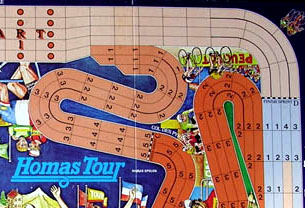

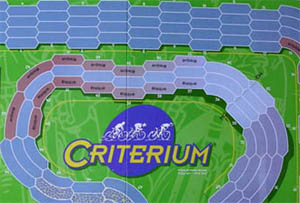
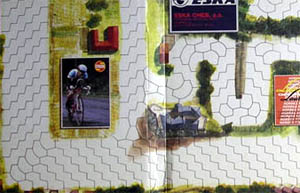

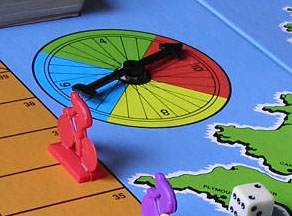
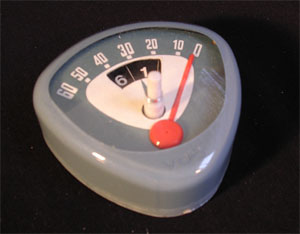


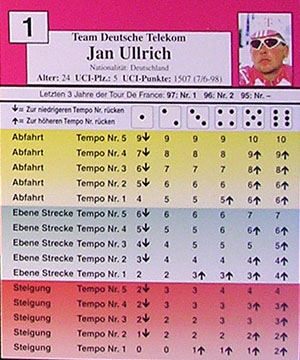

"Die Tour": elegant, and quite
understandable

"Table Tour: Really
understandable!

"Itzuli Mitzuli": beautiful, but hard to understand
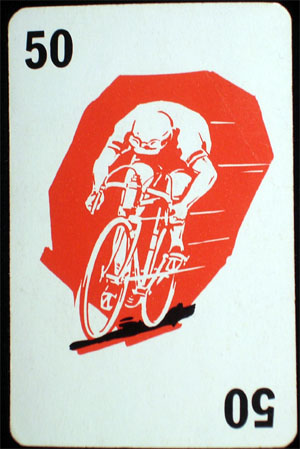
"L'Échappée": Perfect!
"Maillot Jaune"

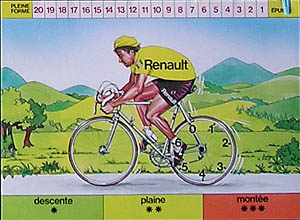
Ciclopist
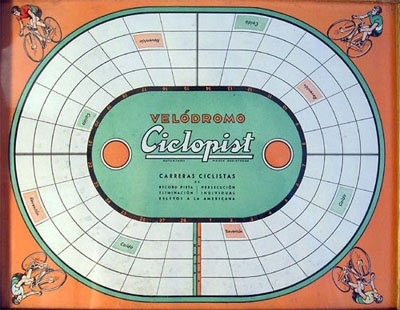
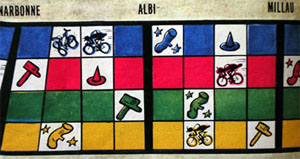
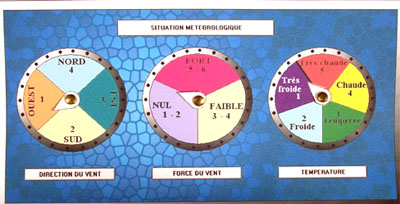
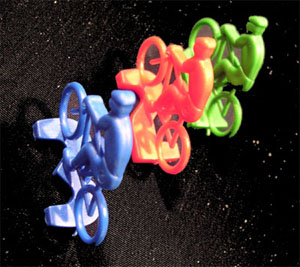
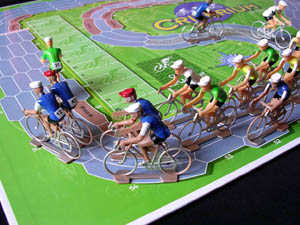
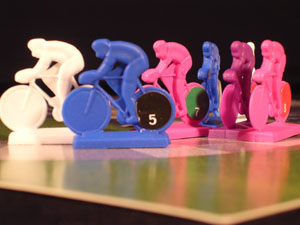
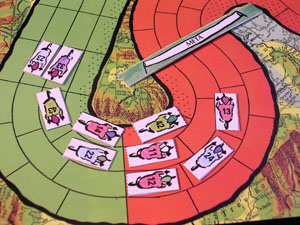
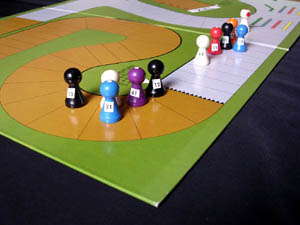
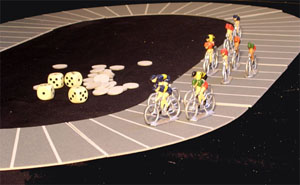
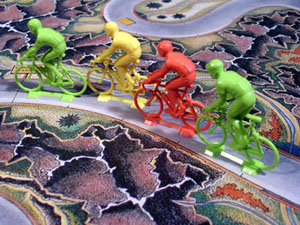
Let's say we want to make a game representing
a stage race. Most chances are that we end up with a game for three to
six players, each of them controll the moves of a team of three or four
cyclists with dice or cards. At the end of the stage we will establish
some kind of system to translate turns and dice throws into minutes and
seconds...
... and then come some questions:
a) How do we make a game with, say,
one hundred (even sixty would be alright) cyclists, a real peloton, and
keep it nonetheless playable?
b) Which is the minimum number of game
turns below which a stage would lose tactical interest? (Fifteen? Twenty?)
c) Moving twenty or thirty cyclists on a game
board (even with simple rules that don't force players to think too much)
will take no less than five minutes per turn (sometimes quite more). Fifteen
turns would take well over an hour.
d) Let's not forget the time needed
to compute and write down all the results of the stage. The more cyclists
we have, the longer it will take.
e) How many stages did we say we wanted
to play this evening?
I guess we have a problem. Either we
reduce the number of stages, the number of players, the number of cyclists
per team, the number of game turns, or all of them...
(Of course, we could use a computer.
There are some good cycling videogames around, but I thought we were talking
of board games.)
... or we have this fantastic idea
we are looking for.
I would bet it can be done. Take "L'Echappée"
(aka "Der Ausreisser"): a simple game without a board. No cyclists to move.
It's fast and fun (though not really complex). A good example of a different
approach.
What's more, not only I think it can be done, but I know some people who are
trying! (Of course, I am trying, but I am not the only one).
VI. Other types
cycling of games (skill games, computer games, solo replay games, webgames, carousels...)
Remember this
is an unfinished text ;-)
VII. A quick
history of cycling board games
Still waiting for someone
to write it.
For a story of anglo-saxon classic cycling games I would recommend Dan Gindling's "Bicycle Collectibles
with price
guide" (p. 57-64). The book is much better than what its title suggests.
So you want to collect cycling board
games?
Well,
I thought there were not going to be too many games... you know, just a
couple of dozens (and half of them impossible to find, anyway). And of
course I did not foresee the room they were going to
take.
Sure it's still fun
to find a new one... until I get home just to realize
that the only place where I can store
itis, er... wait, I think there's room for one more
under the bed.
Not to mention all
the problem related to collecting in general, be it cycling games or anything
else. I just gotta get it. No matter it's so expensive and probably not
worth it. Oh, and I gotta have all the editions too, the big box, the small
box, the one with the words printed on the wrong side of the box, the German
edition, the Dutch edition...
What's worse, I
can't remember the last time I fooled someone to play, oh no, another cycling
game. I need new friends.
 |
 |
 |
 |
 |
|
CULTURE IDEAS |
TOTUM REVOLUTUM THUMBNAILS |
NAMES ALPHABETICAL |
CATEGORIES LISTS |
WHAT'S NEW BLOG |